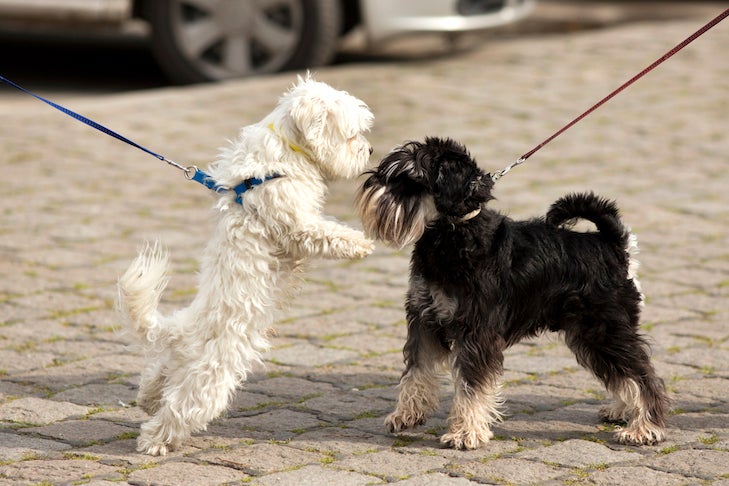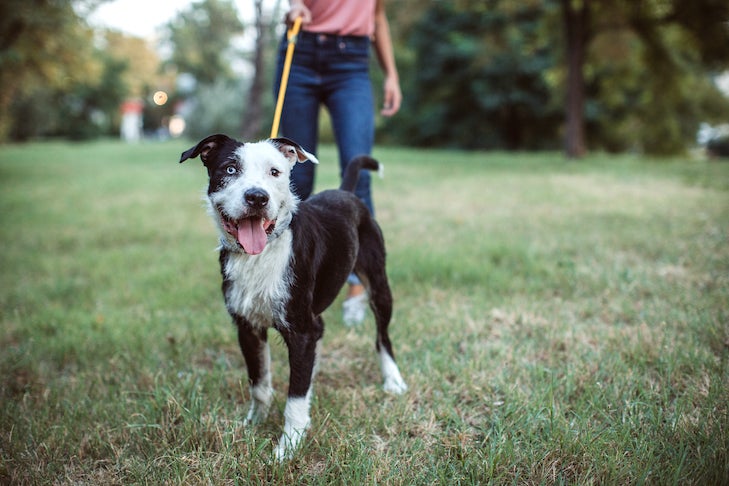Do you dread taking your dog for a walk because they lunge at other dogs, other people, or objects like cars or skateboards? Maybe they bark or growl too. Walking an out-of-control dog is both physically and emotionally exhausting. It’s tempting to avoid walks altogether, but then your dog isn’t getting the mental stimulation and physical exercise they need. So, what do you do? Read on for tips to manage and improve your dog’s lunging behavior.
Understand Why Dogs Lunge
Dog experts often label dogs who lunge and bark during walks as “leash reactive.” A reactive dog is one who becomes overly aroused by normal situations, and a leash reactive dog is one who behaves that way on leash. But what causes this behavior? There are three possible motivations for lunging. The least likely is aggression. Although rare, some dogs truly want to do harm. Fear is a far more common motivator. Using the “I’ll get it before it gets me” strategy, dogs lunge to try to make the feared person, dog, or other object go away. Finally, your dog might be excited to approach the person, dog, or object, but because the leash is preventing that, they become frustrated and lose emotional control.
You need to take all these motivations seriously, but it’s important to understand which one is driving your dog. For example, if your dog is frustrated, lessons in emotional self-control come in handy. If your dog is fearful, building self-confidence is key. However, regardless of the reason for the lunging, some of the basic management tools and treatments are the same.
Manage Your Dog’s Behavior
It’s important to prevent your dog from lunging because every time they do, they’re practicing the behavior and developing a self-reinforcing habit. And the firmer the habit, the harder it will be to change. But how do you prevent lunging? First, never punish your dog for this behavior. You will only exacerbate the problem. Your dog will associate the punishment with the other person, dog, or object which will strengthen their fear or jack up their frustration.
Second, use the correct equipment for walking. A buckle collar can put a lot of pressure on your dog’s throat when they lunge. A front-clip harness is a better choice. It will put the pressure on your dog’s chest and help turn them back toward you when they spring forward. A head halter (also called a head harness) is another option for a leash-reactive dog. It loops around your dog’s nose and allows you to control their head like the reins of a horse. However, many dogs need help adjusting to a halter and they can damage their necks if they hit the end of the leash with too much force. To prevent that, you can clip one leash to their buckle collar and another to their halter, so the collar leash takes the force during lunges and the halter leash gently turns your dog’s head.
Finally, be proactive. Plan your walks for times when your dog is unlikely to encounter any triggers (the people, dogs, or objects that cause the lunging to occur). That might be late at night or with the sunrise. Also choose the quietest route. And always be on the lookout for triggers so you can keep your dog far enough away that they don’t react. That might mean taking evasive action like crossing the street or making a 180-degree turn. If you can distract your dog before they notice the trigger, even better. Constantly monitor the environment and your dog’s body language so you can predict lunging before it occurs and act accordingly.

Change Your Dog’s Emotional Response
Management will prevent your dog from practicing lunging, but it won’t improve their behavior or ease their emotional state. For that, try desensitization and counterconditioning. This technique will change your dog’s emotional response from negative to positive (in the case of fear-based or aggressive reactivity) or from out-of-control excitement to calm (in the case of frustration).
The trick is to get your dog in the presence of their trigger but far enough away they don’t react. This is known as below-threshold intensity. That could be 10 feet, or it could be 40. And different triggers might have different distances. Once you have your dog below threshold, pair the trigger with high-value rewards they would do anything for, like strips of meat, cubes of cheese, or a chance to play with their favorite toy. You want your dog to build a positive association between the wonderful goodies and the trigger.
Start the process with your dog on leash. Wait for them to notice a trigger then immediately present a reward. When they glance at the trigger again, offer another reward. Continue as long as the trigger is present. With enough repetition, your dog will eventually glance at the trigger then turn right back in your direction, as if to say, “I saw it, now where’s my treat?” This tells you that your dog has realized the trigger makes the reward happen, so the positive association is being formed.
Now you can move a tiny bit closer to the trigger and repeat the process. The goal is to slowly reduce the distance between your dog and the trigger until they are within a few feet or less, all while keeping your dog under threshold. Then duplicate the entire procedure again with a new dog or person. Continue to repeat with as many examples of the trigger as necessary to convince your dog that their trigger makes great things happen. As a result, when they see any trigger, they will look to you for a reward instead of lunging.
Try your best to control the environment during this process. You don’t want a dog or stranger sneaking up and putting your dog over threshold. Instead, enlist the assistance of friends so you can coordinate a training plan using them or their dogs as the trigger. You can also try positioning your dog at a set distance from a pathway or street so you can predict passersby but control how far your dog is from them.
Teach Your Dog an Incompatible Alternative Behavior
You can also teach your dog to perform a behavior that is incompatible with lunging. For example, they can’t lunge towards another dog and turn to look at you at the same time. If you heavily reward this alternative behavior, your dog will eventually choose to do it in place of lunging even when their trigger is close by. Some great choices include “Watch me” (where your dog looks at your face), “Touch” (where your dog targets something with their nose), or “Find it” (where you drop treats at your feet for your dog to find). These are easy to teach and easy for your dog to do even when they are emotionally aroused. And more importantly, they redirect your dog’s gaze from the trigger to you.
Whichever behavior you choose, make sure your dog loves to do it. Start training in a quiet environment without distractions and pile on the treats. This will show your dog how easy it is to get rewarded for the new task. Next, build distractions into your training. Then add the trigger at a below-threshold distance. When your dog looks at the trigger, ask for the replacement behavior. Shower them with treats when they obey. Finally, ask for the new behavior while slowly moving closer and closer to the trigger. If your dog reverts to lunging, you’ve moved too far, too fast. Eventually, rather than lunging, your dog will see the trigger as a cue to do the new behavior and earn a reward.

Know When to Get Help
For some dogs, you might be able to work through these techniques on your own and achieve great success in a matter of weeks. For other dogs, it’s advisable to get help from an animal behaviorist or a professional dog trainer with leash reactivity experience. Your dog might also benefit from a consult with a veterinary behaviorist. If your dog is too worked up to learn, medication can control their arousal levels during training allowing them to make more progress.
Lunging on leash can usually be modified into more polite and acceptable behavior. At the very least, you can minimize your dog’s outbursts with good management. It takes patience and dedication to your dog and the training protocols, but walks can eventually be stress-free for both you and your dog.

